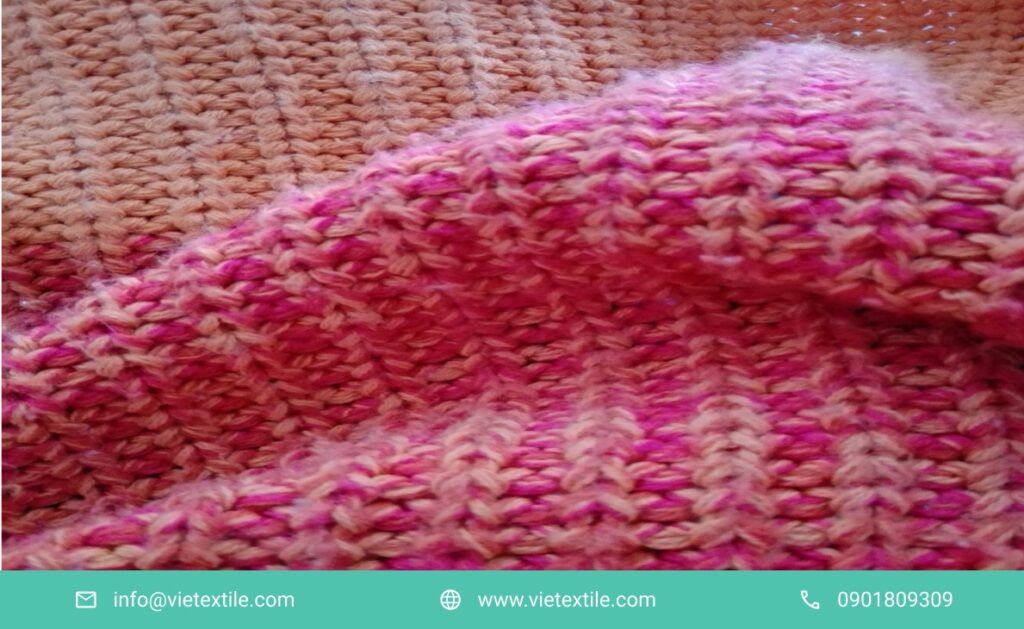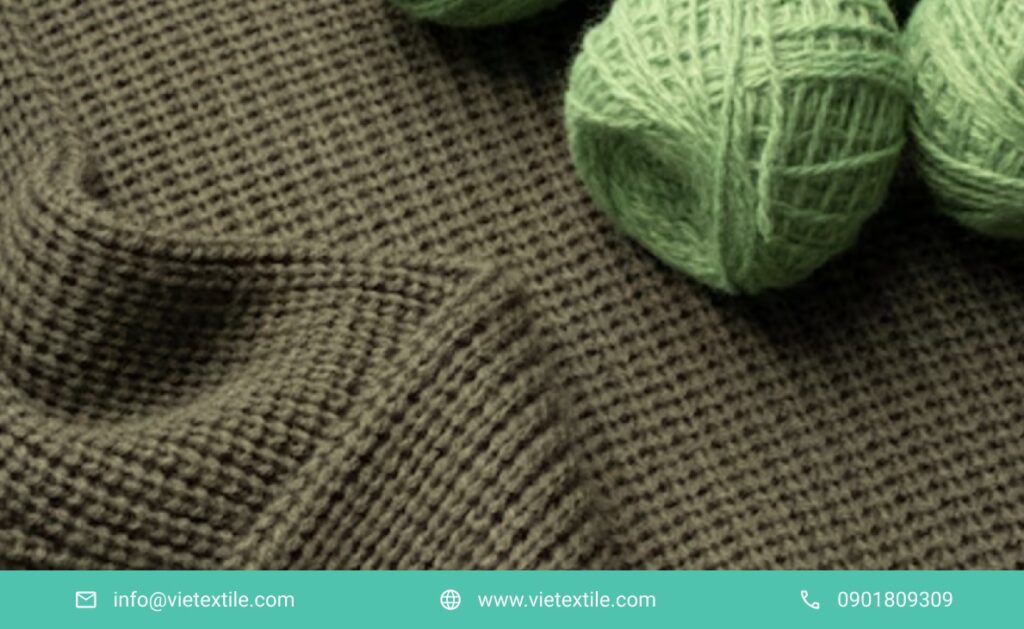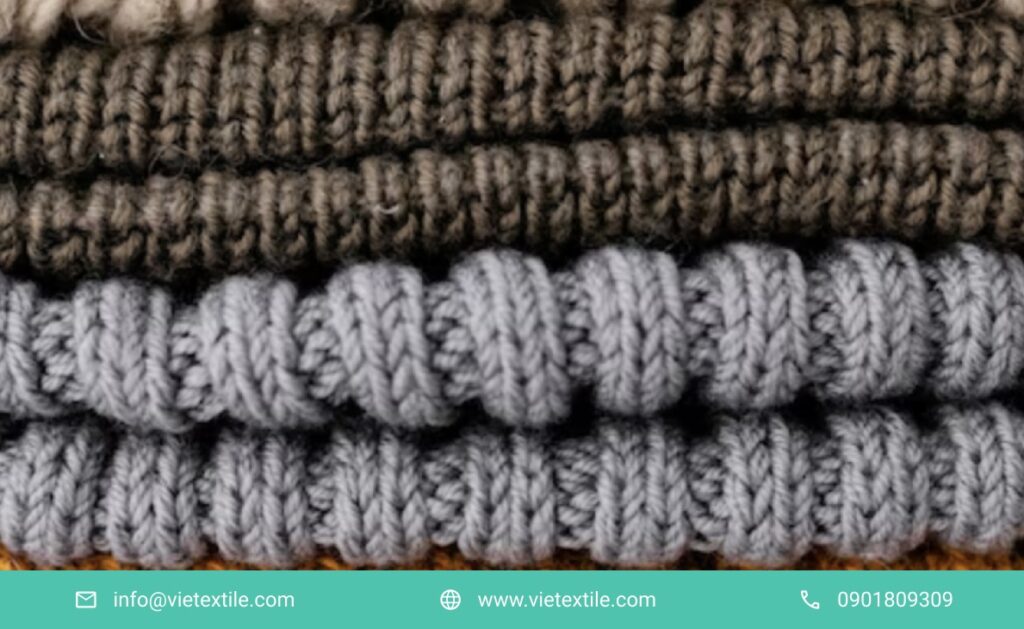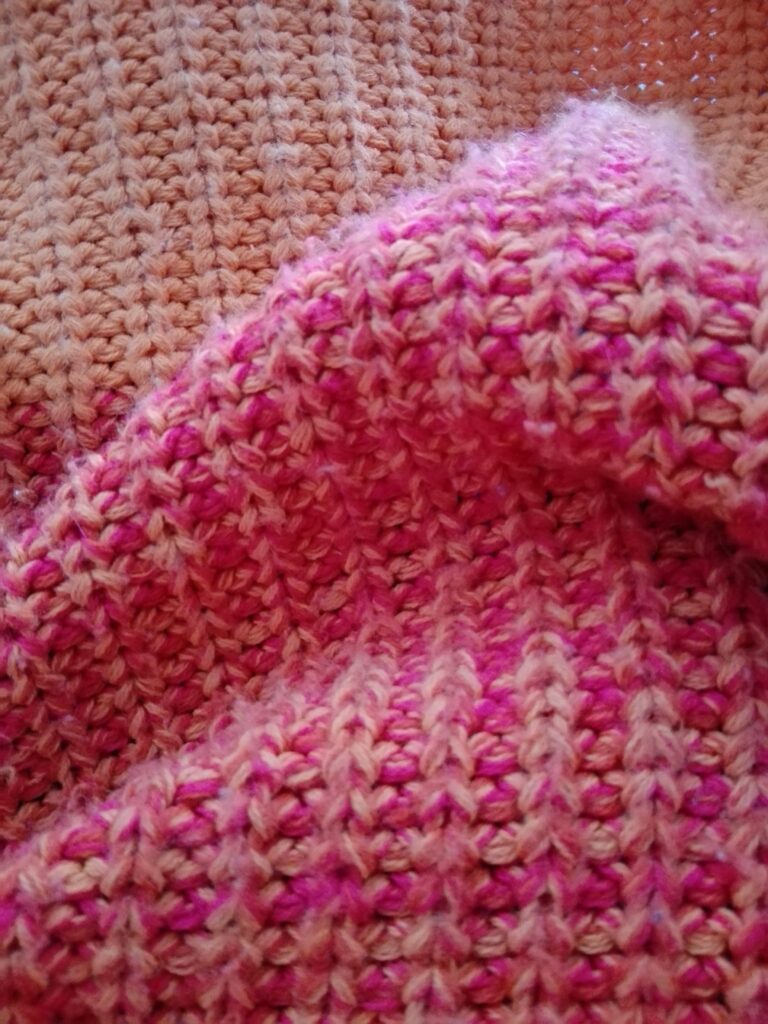Properly caring for knit fabric not only extends a product’s durability but also maintains its long-term aesthetic appeal. Knit fabric is a popular material in modern fashion, especially for items like t-shirts, sportswear, sleepwear, and everyday clothes. However, without proper care, the fabric can easily pill, shrink, lose its shape, or lose elasticity.
In this article, VieTextile will share a detailed guide on how to care for knit fabrics—from washing, drying, and ironing to storing—with effective tips for both individuals and apparel manufacturers.

1. What is Knit Fabric? Why Proper Care is Essential?
Nội dung tóm tắt
ToggleKnit fabric is a type of textile created by interlocking loops of yarn horizontally (weft knitting) or vertically (warp knitting). Compared to woven fabric, knit fabric has a more open, softer, and more elastic structure. However, this flexibility makes the fabric prone to losing its shape, stretching, or pilling if not cared for correctly.
Some key advantages include:
- Natural stretch, providing a snug and flexible fit
- Good sweat absorption, suitable for sportswear and daily wear
- Soft, comfortable surface against the skin
- Easy to form, offering versatility in fashion design
However, because of its looped structure, this type of fabric can easily deform, pill, or shrink if not washed and cared for properly. Read more: Everything about knit fabric: from concept to application
2. Why Do You Need to Know How to Care for Knit Fabric?

Many customers wonder why knit products deteriorate or lose their shape quickly, while other fabrics are more durable. The reasons stem from:
- Its looped structure is prone to stretching and deformation.
- It is easily damaged by high temperatures, friction, and chemicals.
- Its natural stretch causes clothes to lose their shape quickly if hung incorrectly.
Understanding and following the correct knit fabric care process is the only way to ensure optimal shape retention, color, and durability for your products.
3. How to Wash Knit Fabric Correctly

3.1. Hand Washing – The First and Best Choice
Hand washing minimizes harsh mechanical action on the fabric’s fibers. This is the ideal method for knit wool, fabrics with spandex, or antibacterial knits.
Hand Washing Instructions:
- Use cold or lukewarm water (under 30°C).
- Use a mild detergent (baby shampoo also works).
- Soak for 5–10 minutes, gently knead, and avoid strong twisting.
- Rinse thoroughly and place on a towel to absorb excess water.
3.2. Machine Washing – Follow 5 Important Principles
If you must machine wash, keep these points in mind:
- Select the “Delicate” or “Wool/Handwash” cycle.
- Turn garments inside out.
- Place them in a mesh laundry bag.
- Use cold water, not exceeding 30°C.
- Do not wash with rough clothes like jeans, jackets, or items with metal zippers.
4. How to Dry Knit Fabric
Incorrect drying is a common cause of stretching and loss of shape.
4.1. The Ideal Way to Dry:
- Lay flat on a horizontal surface (you can use a drying rack or a towel underneath).
- Avoid using hangers, as the weight of the water will stretch the garment.
- Avoid direct sunlight; dry in a cool, well-ventilated area.
4.2. What to Avoid:
- Wringing too hard before drying.
- Using a high-heat dryer (only use the “Air dry” setting if necessary).
- Hanging on a hanger while the fabric is still wet.
5. How to Iron and Smooth Knit Fabric
Knit fabric should not be ironed directly with high heat, as it can deform the fiber structure. If ironing is necessary, do the following:
- Use a steam iron on a low temperature setting (below 110°C).
- Place a thin cotton cloth between the iron and the fabric.
- Iron the inside of the garment, working gently in the direction of the fibers.
- Do not iron when the fabric is wet or heavily damp.
6. Tips for Common Knit Fabric Problems
6.1. How to Handle Pilling
Pilling occurs when the fabric’s loops are frequently rubbed. You can fix this by using:
- A specialized fabric shaver.
- A mini fabric razor.
- Applying tape and gently peeling it off along the direction of the fibers. To prevent pilling, avoid washing with rough or rigid clothes.
6.2. How to Fix Shrinking After Washing
If your garment has shrunk after washing, try this:
- Soak the fabric in cold water for 15–20 minutes.
- Lay it flat on a towel and gently stretch the fabric horizontally and vertically.
- Let it air dry naturally; do not hang or use a dryer. This helps the fibers return to their original shape.
6.3. Restoring the Shape of Knit T-Shirts
Garments can easily lose their shape after a few wears, especially at the shoulders and neck. To restore the shape of a knit t-shirt:
- Lightly mist water on the area you want to reshape.
- Use a low-temperature steam iron with a thin cloth liner.
- Gently iron to reshape the garment.
7. Storing Knit Fabric Correctly in Closets/Storage
This step is often overlooked but is crucial for keeping fabrics looking new.
The Ideal Storage Method:
- Fold neatly instead of hanging on hangers (especially for sweaters and jumpers).
- Store in a breathable fabric bag, not a plastic bag.
- Add a moisture-absorbing packet to prevent mildew.
- Avoid placing near sharp objects or zippers.
See more: Knit fabric manufacturing plant – Providing high-quality apparel solutions
8. Special Considerations for Premium Knit Fabrics
8.1. Wool/Cashmere Fabrics:
- Prioritize dry cleaning.
- Can be hand-washed with mild shampoo.
- Absolutely do not twist or tumble dry on high heat.
8.2. Spandex / Sportswear Fabrics:
- Sensitive to heat.
- Avoid direct ironing and harsh sunlight.
8.3. Antibacterial Knit Fabrics:
- Must follow the manufacturer’s care instructions.
- Limit contact with bleach or hot water.
9. Conclusion: Proper Care Increases Value and Product Lifespan
By applying the correct washing, drying, ironing, and storing procedures, you not only help knit fabric products last longer and look better but also contribute to protecting your health, saving costs, and enhancing your daily wearing experience.
✅ Discover the premium antibacterial knit fabrics supplied by VieTextile – safe for the skin, and colorfast over time.
Are you looking for a source of high-quality, easy-to-care-for knit fabrics suitable for fashion, sportswear, or antibacterial products?
Contact for a consultation VieTextile is a proud and trusted partner in the textile industry, specializing in the supply of:
- Single jersey, interlock, rib, and pique knit fabrics
- Knit fabrics blended with spandex, antibacterial, and eco-friendly materials
- Technical consultation, care, and custom manufacturing solutions
Contact the VieTextile team now for in-depth consultation or to receive free fabric samples
Frequently Asked Questions (FAQ) about Caring for Knit Fabric
1. Why is it important to care for knit fabric correctly? Knit fabric has a soft, stretchy looped structure. If not washed, dried, and stored correctly, it is very prone to pilling, losing its shape, shrinking, or losing elasticity. Proper care helps extend the fabric’s lifespan and maintains the product’s original appearance.
2. Should knit fabric be hand-washed or machine-washed? It is best to hand-wash to limit friction and strong pulling. However, if using a machine, you should select the “Delicate” or “Wool” cycle, turn the garments inside out, and use a laundry bag to protect the fibers.
3. How can I prevent knit fabric from pilling? To prevent pilling, you should:
- Wash separately from rough clothes.
- Avoid washing with items that have zippers or metal buttons.
- Limit strong friction.
- Use a fabric shaver or mini razor if pilling has already occurred.
4. If knit fabric shrinks after washing, can it be fixed? It can be temporarily fixed by:
- Soaking the garment in cold water for about 15–20 minutes.
- Laying it flat on a towel and gently stretching it horizontally and vertically.
- Allowing it to air dry naturally, without hanging or using a dryer.
5. Should I use an iron on knit fabric? Yes, but with caution. You should use a steam iron on a low-temperature setting, place a thin cotton cloth underneath, and iron the inside of the garment. Do not iron directly on high heat or when the fabric is wet.
6. How should knit fabric be stored? Knit fabric should be folded neatly and stored in a breathable fabric bag, away from damp areas or direct sunlight. You should avoid hanging it on a hanger, as this can easily cause it to lose its shape, especially for sweaters, jumpers, or stretchy products.
7. Is knit fabric more durable than woven fabric? Each type has its own characteristics. Knit fabric is soft, stretchy, and suitable for everyday wear but is less durable than woven fabric if cared for incorrectly. Proper care is the key to increasing its durability.










